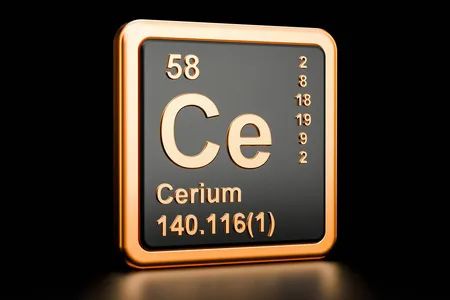Air oxidation method is an oxidation method that utilizes oxygen in the air to oxidize cerium to tetravalent under certain conditions. This method typically involves roasting fluorocarbon cerium ore concentrate, rare earth oxalates, and carbonates in air (known as roasting oxidation) or roasting rare earth hydroxides (dry air oxidation) or introducing air into rare earth hydroxides slurry (wet air oxidation) for oxidation.
1、 Roasting oxidation
Roasting the fluorocarbon cerium concentrate in air at 500 ℃ or roasting the Baiyunebo rare earth concentrate with sodium carbonate in air at 600-700 ℃. During the decomposition of rare earth minerals, cerium in the minerals is oxidized to tetravalent. The methods for separating cerium from calcined products include rare earth sulfate double salt method, solvent extraction method, etc.
In addition to the oxidation roasting of rare earth concentrate, salts such as rare earth oxalate and rare earth carbonate undergo roasting decomposition in an air atmosphere, and cerium is oxidized to CeO2. To ensure good solubility of the rare earth oxide mixture obtained by roasting, the roasting temperature should not be too high, usually between 700 and 800 ℃. Oxides can be dissolved in 1-1.5mol/L sulfuric acid solution or 4-5mol/L nitric acid solution. When leaching roasted ore with sulfuric acid and nitric acid, cerium mainly enters the solution in a tetravalent form. The former involves obtaining a rare earth sulfate solution containing 50g/L REO at around 45 ℃, and then producing cerium dioxide using the P204 extraction method; The latter involves preparing a rare earth nitrate solution containing REO of 150-200g/L at a temperature of 80-85 ℃, and then using TBP extraction to separate cerium.
When rare earth oxides are dissolved with dilute sulfuric acid or nitric acid, CeO2 is relatively insoluble. Therefore, a small amount of hydrofluoric acid needs to be added to the solution as a catalyst in the later stage of dissolution to improve the solubility of CeO2.
2、 Dry air oxidation
Place the rare earth hydroxide in a drying furnace and oxidize it under ventilated conditions at 100-120 ℃ for 16-24 hours. The oxidation reaction is as follows:
4Ce(OH)3+O2+2H2O=4Ce(OH)4
The oxidation rate of cerium can reach 97%. If the oxidation temperature is further increased to 140 ℃, the oxidation time can be shortened to 4-6 hours, and the oxidation rate of cerium can also reach 97%~98%. The dry air oxidation process produces a large amount of dust and poor labor conditions, which are currently mainly used in the laboratory.
3、 Atmospheric wet air oxidation
Mix rare earth hydroxide with water to form a slurry, control the REO concentration to 50-70g/L, add NaOH to increase the alkalinity of the slurry to 0.15-0.30mol/L, and when heated to 85 ℃, directly introduce air to oxidize all trivalent cerium in the slurry to tetravalent cerium. During the oxidation process, the evaporation of water is relatively large, so a certain amount of water should be supplemented at any time to maintain a more stable concentration of rare earth. When 40L of slurry is oxidized in each batch, the oxidation time is 4-5 hours, and the oxidation rate of cerium can reach 98%. When 8m3 of rare earth hydroxide slurry is oxidized each time, the air flow rate is 8-12m3/min, and the oxidation time is increased to 15h, the oxidation rate of cerium can reach 97%~98%.
The characteristics of the atmospheric wet air oxidation method are: high oxidation rate of cerium, large output, good working conditions, simple operation, and this method is commonly used in industry to produce crude cerium dioxide.
4、 Pressurized wet air oxidation
Under normal pressure, air oxidation takes a longer time, and people shorten the oxidation time by using pressure. The increase of air pressure, that is, the increase of oxygen partial pressure in the system, is conducive to the dissolution of oxygen in the solution and the diffusion of oxygen to the surface diffusion of rare earth hydroxide particles, thus accelerating the oxidation process.
Mix rare earth hydroxide with water to about 60g/L, adjust the pH to 13 with sodium hydroxide, raise the temperature to about 80 ℃, introduce air for oxidation, control the pressure at 0.4MPa, and oxidize for 1 hour. The oxidation rate of cerium can reach over 95%. In actual production, the oxidation raw material rare earth hydroxide is obtained by alkali conversion through precipitation of rare earth sodium sulfate complex salt. In order to shorten the process, the precipitation of rare earth sodium sulfate complex salt and alkaline solution can be added to a pressurized oxidation tank, maintaining a certain pressure and temperature. Air or rich oxygen can be introduced to convert the rare earth in the complex salt into rare earth hydroxides, and at the same time, Ce (OH) 3 in it can be oxidized to Ce (OH) 4.
Under pressurized conditions, the alkali conversion rate of the complex salt, the oxidation rate of cerium, and the oxidation rate of cerium are all improved. After 45 minutes of reaction, the conversion rate of double salt alkali and the oxidation rate of cerium reached over 96%.
Post time: May-09-2023
